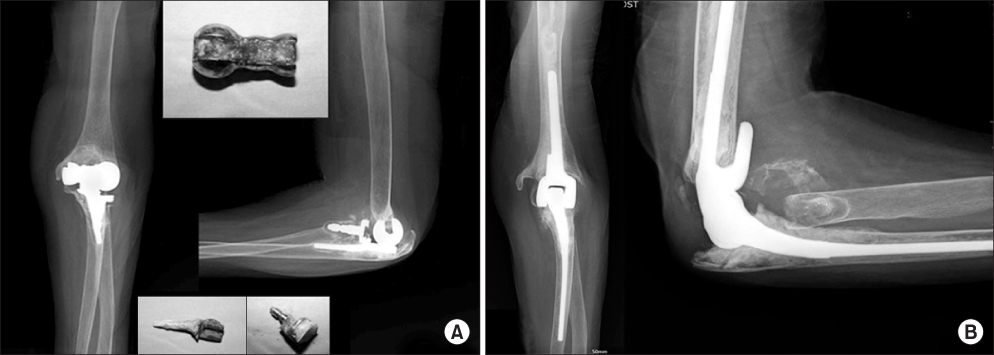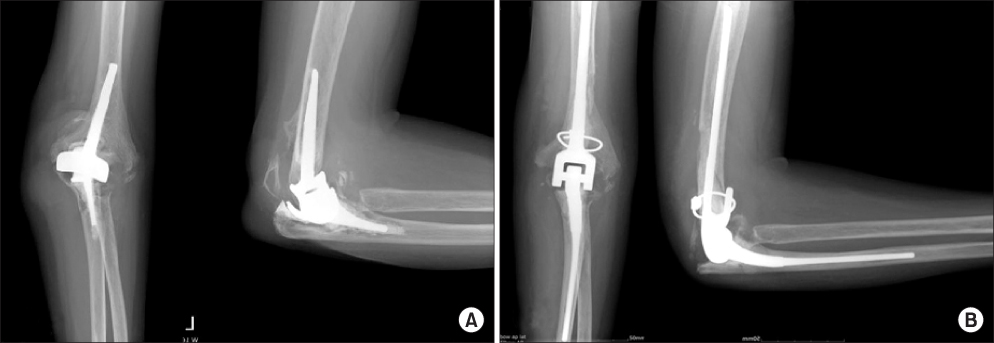J Korean Orthop Assoc.
2010 Feb;45(1):10-15. 10.4055/jkoa.2010.45.1.10.
Complications and Revision Rate as the Type of Prosthesis of Total Elbow Replacement: Long-term Follow-up in Korea
- Affiliations
-
- 1Department of Orthopedic Surgery, Seoul St. Mary's Hospital, The Catholic University of Korea College of Medicine, Seoul, Korea.
- 2Department of Orthopedic Surgery, St. Mary's Hospital, The Catholic University of Korea College of Medicine, Seoul, Korea. skrhee@catholic.ac.kr
- KMID: 2185588
- DOI: http://doi.org/10.4055/jkoa.2010.45.1.10
Abstract
- PURPOSE
Few studies have compared the outcomes, complications and revision rate of a total elbow replacement (TER) prosthetic design. This study examined a series of patients with semiconstrained and unconstrained total elbow replacements (TER) and evaluated them for any functional differences, complications and revision rates that might be attributable to the prosthetic design.
MATERIALS AND METHODS
A total 78 cases of primary TER was performed in 71 patients. Their mean age at TER was 54 years. The causes of TER were rheumatoid arthritis in 42, post-traumatic arthritis and osteoarthritis 24 and 5 patients, respectively. Unconstrained and semiconstrained TER was employed in 35 and 43 cases, respectively. The end results of TER by the Mayo elbow performance score (MEPS), their elbow range of motion before and after surgery, their complications and revision rates after an average 13 year follow-up were evaluated.
RESULTS
The MEPS was improved from 33 points pre-operatively to 87 points post-operatively (p<0.001). Active flexion-extension elbow motions were also improved markedly from 27degrees-86degrees pre-operatively to 16degrees-128degrees postoperatively (p<0.001). There was no significant difference between the semiconstrained and unconstrained TER in the post-operative MEPS (p=0.764) and range of motion (p=0.728). The complication rate was much higher in the unconstrained groups than in the semiconstrained group (p=0.014). The mean total revision rate was 29.5%. There was no significant difference in revision rate between the unconstrained and semiconstrained groups (p=0.402). Loosening was found in a total of 12 cases (15.4%). There was also no significant difference in loosening between the semiconstrained and unconstrained groups (p=0.382).
CONCLUSION
Favorable results of MEPS and elbow motion were obtained in both the unconstrained and semiconstrained types after an average 13 year follow up after TER. However, the semiconstrained type of TER showed a lower complication rate than the unconstrained type of TER.
Keyword
MeSH Terms
Figure
Reference
-
1. Gill DR, Morrey BF. The Coonrad-Morrey total elbow ar-throplasty in patients who have rheumatoid arthritis. A ten to fifteen-year follow-up study. J Bone Joint Surg Am. 1998. 80:1327–1335.
Article2. Ray PS, Kakarlapudi K, Rajsekhar C, Bhamra MS. Total elbow arthroplasty as primary treatment for distal humeral fractures in elderly patients. Injury. 2000. 31:687–692.
Article3. Gambirasio R, Riand N, Stern R, Hoffmeyer P. Total elbow replacement for complex fractures of the distal humerus. An option for the elderly patient. J Bone Joint Surg Br. 2001. 83:974–978.4. Pritchard RW. Anatomic surface elbow arthroplasty: A preliminary report. Clin Orthop Relat Res. 1983. 179:223–230.
Article5. Kudo H, Iwano K. Total elbow arthroplasty with a non-constrained surface-replacement prosthesis in patients who have rheumatoid arthritis. A long-term follow-up study. J Bone Joint Surg Am. 1990. 72:355–362.
Article6. Madsen F, Gudmundson GH, Søjbjerg JO, Sneppen O. The pritchard mark II elbow prosthesis in rheumatoid arthritis. Acta orthop Scand. 1989. 60:249–253.
Article7. O'Driscoll SW, An KN, Korinek S, Morrey BF. Kinematics of semi-constrained total elbow arthroplasty. J Bone Joint Surg Br. 1992. 74:297–299.8. Morrey BF, An KN, Chao EYS. Morrey BF, editor. Functional evaluation of the elbow. The Elbow and its Disorder. 1993. Philadelphia: WB Saunders.
Article9. Kozak TK, Adams RA, Morrey BF. Total elbow arthroplasty in primary osteoarthritis of the elbow. J Arthroplasty. 1998. 13:837–842.
Article10. Schneeberger AG, Adams R, Morrey BF. Semiconstrained total elbow replacement for the treatment of post-traumatic osteoarthrosis. J Bone Joint Surg Am. 1997. 79:1211–1222.
Article11. Moro JK, King GJ. Total elbow arthroplasty in the treatment of posttraumatic conditions of the elbow. Clin Orthop Relat Res. 2000. 370:102–114.
Article12. Ramsey ML, Adams RA, Morrey BF. Instability of the elbow treated with semiconstrained total elbow arthroplasty. J Bone Joint Surg Am. 1999. 81:38–47.
Article13. Cobb TK, Morrey BF. Total elbow arthroplasty as primary treatment for distal humeral fractures in elderly patients. J Bone Joint Surg Am. 1997. 79:826–832.
Article14. Kamineni S, Morrey BF. Distal humeral fractures treated with noncustom total elbow replacement. J Bone Joint Surg Am. 2004. 86:940–947.
Article15. Hastings H 2nd, Theng CS. Total elbow replacement for distal humerus fractures and traumatic deformity: results and complications of semiconstrained implants and design rationale for the discovery elbow system. Am J Orthop. 2003. 32:Suppl. 20–28.16. Frankle MA, Herscovici D Jr, DiPasquale TG, Vasey MB, Sanders RW. A comparison of open reduction and internal fixation and primary total elbow arthroplasty in the treatment of intraarticular distal humerus fractures in women older than age 65. J Orthop Trauma. 2003. 17:473–480.
Article17. Ring D, Koris M, Jupiter JB. Instability after total elbow arthroplasty. Orthop Clin North Am. 2001. 32:671–677.
Article18. O'Driscoll SW, King GJ. Treatment of instability after total elbow arthroplasty. Orthop Clin North Am. 2001. 32:679–695.19. Wright TW, Wong AM, Jaffe R. Functional outcome comparison of semiconstrained and unconstrained total elbow arthroplasties. J Shoulder Elbow Surg. 2000. 9:524–531.
Article20. Patil N, Cheung EV, Mow CS. High revision rate after total elbow arthroplasty with a linked semiconstrained device. Orthopedics. 2009. 32:321.
Article21. Coyte PC, Hawker G, Croxford R, Wright JG. Rates of revision knee replacement in Ontario, Canada. J Bone Joint Surg Am. 1999. 81:773–782.
Article22. Hooper GJ, Rothwell AG, Stringer M, Frampton C. Revision following cemented and uncemented primary total hip replacement: a seven-year analysis from the New Zealand Joint Registry. J Bone Joint Surg Br. 2009. 91:451–458.23. Morrey BF. Morrey BF, editor. Complications of elbow replacement surgery. The Elbow and its Disorder. 2000. Philadelphia: WB Saunders.24. Pugh DM, McKee MD. Elbow extension weakness following semi-constrained total elbow arthroplasty: A cause for con-cern. 2002. In : the American shoulder and elbow surgeons specialty day, American academy of orthopaedic surgeons, 69th annual meeting; Dallas:25. McKee MD, Pugh DM, Richards RR, Pedersen E, Jones C, Schemitsch EH. Effect of humeral condylar resection on strength and functional outcome after semiconstrained total elbow arthroplasty. J Bone Joint Surg Am. 2003. 85:802–807.
Article26. Morrey BF. Morrey BF, editor. Postoperative management of elbow replacement surgery. The Elbow and its Disorder. 2000. Philadelphia: WB Saunders.
- Full Text Links
- Actions
-
Cited
- CITED
-
- Close
- Share
- Similar articles
-
- Reverse Total Shoulder Arthroplasty: Complications
- Revision Total Elbow Replacement Arthroplasty with an Allograft-Prosthesis Composite: Case Series and Technical Points
- Total Elbow Replacement
- Total Elbow Arthroplasty: Clinical Outcomes, Complications, and Revision Surgery
- Comparison of Revision Rates Due to Aseptic Loosening between High-Flex and Conventional Knee Prostheses



